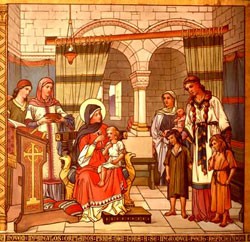Feast Day – 16 November
 Margaret, the Saxon princess who was to become Queen of Scotland and a canonised saint, was born in 1045. The eldest of three children, descended from King Alfred the Great; her great‑grandfather was Aethelred II the Unready, Her grandfather Edmund II Ironside and her father Edward Aethling the Exile. Saxon Kings to a man. Her mother, Agatha was a niece of the Holy Roman Emperor, Henry III. Margaret’s sister Christina, became the Abbess of Romsey while her younger brother, Edgar the Aethling briefly became the un‑crowned king of England.
Margaret, the Saxon princess who was to become Queen of Scotland and a canonised saint, was born in 1045. The eldest of three children, descended from King Alfred the Great; her great‑grandfather was Aethelred II the Unready, Her grandfather Edmund II Ironside and her father Edward Aethling the Exile. Saxon Kings to a man. Her mother, Agatha was a niece of the Holy Roman Emperor, Henry III. Margaret’s sister Christina, became the Abbess of Romsey while her younger brother, Edgar the Aethling briefly became the un‑crowned king of England.
With rivalry over the English throne at fever pitch, her father as a young man and rightful heir of Edmund Ironside, was taken to the Hungarian court for safety. A safe haven known for its qualities of erudition and sanctity, established by King Istvan (St Stephen I). There Edward married Agatha, and Margaret and her sister and brother were born. King Edward the Confessor being without heirs, summoned his nephew, Margaret’s father, to return to England with his family. They arrived home in 1057 and within weeks Edward the Aethling was taken ill and died, leaving his son Edgar as heir to the throne of England at the age of seven. When William the Conqueror invaded England in 1066, Edgar submitted to him, but realising that in those days of sudden unexplained deaths his life was in deadly peril, Margaret fled with him to Scotland where they were welcomed on landing at the Firth of Forth by the King of the Scots, Malcolm III. At thirty‑five and newly widowed, he was renowned mostly as a warrior.
Margaret, at twenty one a ‘Pearl of’ Great price” says her biographer, Turgot, later Bishop of St Andrews, was famous for her beauty, learning, piety, mercy and innate sense of justice. She soon became a major adornment of the royal court at Dunfermline where, say the Anglo‑Saxon chroniclers, “the King began to yearn for for Edgar’s sister as his wife…. by her zeal and industry the King laid aside his barbarity of manner and became more refined” ‑ in a word he was a complete barbarian who could neither read nor write; his fame lay in having defeated and killed Macbeth, the murderer of his father Duncan I, in 1057. Since then his main recreation was launching savage attacks on his English neighbours; he adored his wife and was happy to leave the effective government of the realm to her. In effect she reformed the King and with it the people and the church as it then existed in Scotland. Centuries ahead of her time (a great role for Meryl Streep who she resembles in etchings!) she became a truly authoritarian and influential woman, who used all her powers for reform. She was also, by her persuasiveness and example, as embroideress and worldwide importer of new materials and styles, an arbiter of fashion and interior design – “never had the court blazed with such elegance”. By contrast, the Queen supported twenty‑four poor families for the rest of her days and during Lent, with her husband, personally waited on and served three hundred poor people with specially prepared dishes. As for the king, he readily obeyed her wishes and prudent counsel in all things including the administration of the laws of the realm.
Margaret was also an exemplary mother. All her sons were to inherit the throne; Donald III (Donaldbane), Duncan II, Edgar, Alexander I, and David I. Of her two daughters, Matilda and Mary, the former married Henry I of England through whose daughter, Empress Matilda, the English crown descends through the female line to the present day. Margaret died suddenly in 1093 at the age of only fortyeight; sadly, Malcolm, away on his fifth invasion of England was killed in battle at Alnwick, Northumberland, four days before the death of the Queen.